The Greater Swiss Mountain Dog, often affectionately called the “Swissy,” is a breed that captures hearts with its striking appearance, gentle temperament, and unmatched loyalty. Originating in the picturesque Swiss Alps, these dogs were historically bred for drafting, herding, and guarding, making them one of the most versatile working breeds. Today, they continue to charm dog lovers around the world with their intelligence, strength, and social nature.
Whether you’re drawn to their tri-colored coats, their family-friendly demeanor, or their ability to form deep bonds with their owners, the Greater Swiss Mountain Dog is more than just a pet—they’re a devoted companion. In this post, we’ll explore what makes this breed so special, from their temperament and care needs to their suitability for active families. If you’re considering welcoming a Swissy into your life or simply want to learn more about these incredible dogs, read on!
A Brief Introduction to the Greater Swiss Mountain Dog
Origin and History of the Breed (Switzerland, Swiss Alps)
The Greater Swiss Mountain Dog traces its roots back to the picturesque landscapes of Switzerland, specifically the Swiss Alps. This ancient breed is believed to have descended from large mastiff-like dogs brought to the region by Roman soldiers over 2,000 years ago. These hardy dogs adapted to the rugged mountain terrain and harsh climate, becoming indispensable companions for Swiss farmers and herders. Historically, they served as multipurpose working dogs, excelling in tasks like pulling carts loaded with goods, guarding livestock, and herding cattle. Often referred to as one of the four Swiss Sennenhund breeds, the Greater Swiss Mountain Dog is the largest and most robust of the group, which also includes the Bernese Mountain Dog, Appenzeller Sennenhund, and Entlebucher Sennenhund.
Despite their historical significance, the breed’s numbers dwindled during the late 19th century due to the increasing use of mechanized farming equipment. However, thanks to the efforts of Swiss dog enthusiasts like Professor Albert Heim, the breed was rediscovered and preserved. Today, the Greater Swiss Mountain Dog is celebrated worldwide for its rich heritage and enduring versatility.
Role and Classification as a Working Group Dog
The Greater Swiss Mountain Dog is officially classified as a member of the Working Group by organizations like the American Kennel Club (AKC). This designation highlights their natural aptitude for jobs that require strength, intelligence, and endurance. Historically, their primary roles included drafting (pulling carts), guarding farms and livestock, and assisting in herding activities. These tasks required a dependable and versatile dog, and the Swissy excelled in all aspects.
In modern times, while their working roles have diminished, their traits remain invaluable. Greater Swiss Mountain Dogs are still used in drafting competitions, search and rescue operations, and therapy work. Their loyalty, intelligence, and calm demeanor also make them exceptional companions in family homes. Whether pulling a cart at a competition or lounging with their family, Swissies embody the hardworking and dependable spirit of the Working Group.
Physical Characteristics: Tri-Colored Coat, Large Size, and Muscular Build
The Greater Swiss Mountain Dog is a strikingly handsome breed, instantly recognizable by its large size and tri-colored coat. Adult males typically weigh between 100 and 140 pounds, while females range from 85 to 110 pounds. Standing tall and proud, their muscular build and sturdy frame reflect their history as hardworking farm dogs capable of pulling heavy loads and navigating mountainous terrain.
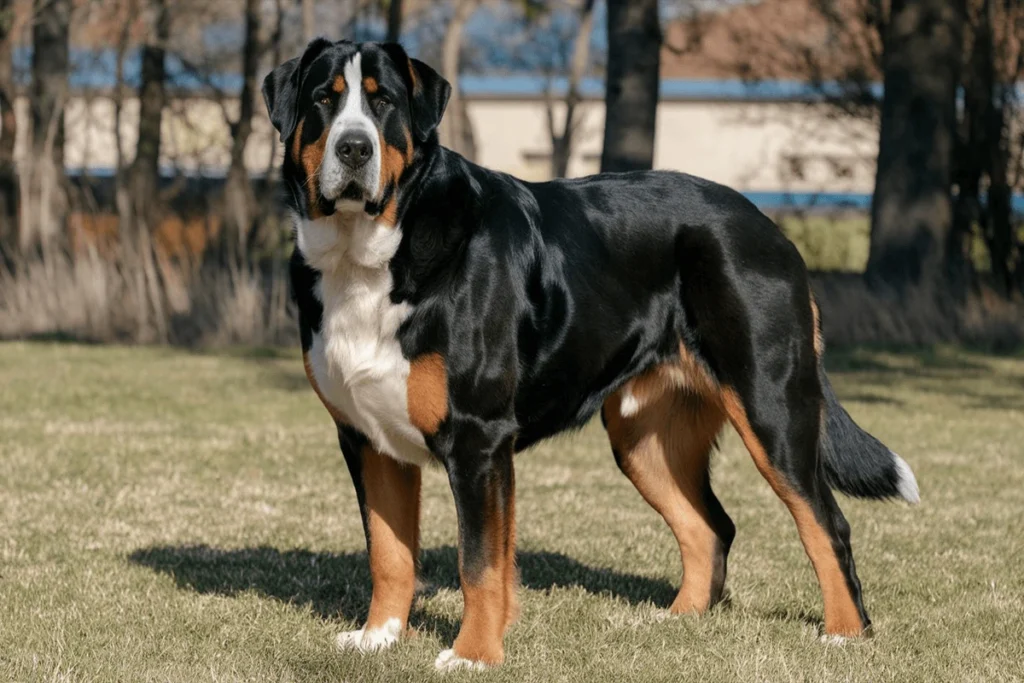
Their distinctive tri-colored coat features a jet-black base with rich rust markings on the cheeks, chest, legs, and above the eyes, complemented by bright white markings on the face, chest, and paws. This unique combination of colors gives them a noble and eye-catching appearance. The breed’s short, dense double coat not only adds to their visual appeal but also provides protection against the cold climates of the Swiss Alps.
In addition to their physical strength and beauty, the Swissy’s dark, almond-shaped eyes convey intelligence and warmth, while their broad head and sturdy neck exude power. Despite their imposing size, these dogs carry themselves with a gentle, approachable demeanor, making them a perfect blend of strength and gentleness.
Traits That Make the Greater Swiss Mountain Dog Irresistible
Temperament: Loyal, Gentle, Intelligent, and Social
Swissies are fiercely loyal and love their families. They thrive on human companionship and want to be involved in daily life. Their gentle demeanor makes them trustworthy, even in high-energy situations or around strangers. They are naturally intelligent and eager to learn, which makes training straightforward and enjoyable for both dog and owner.
Swissies are highly social dogs who love meeting people and other animals. They bond quickly and deeply with their owners and maintain strong, lifelong attachments. While friendly, they also exhibit protective instincts, ensuring their family feels safe. Their ability to balance loyalty, intelligence, and a social nature sets them apart as a truly exceptional breed.
Why They Are a Top Choice Among Loyal Dog Breeds
Few breeds can match the loyalty of a Swissy. They form unshakable bonds with their families, often following their owners from room to room. This “velcro dog” behavior showcases their need to stay close to loved ones. Their loyalty makes them reliable protectors, always alert but never unnecessarily aggressive.
Unlike some overly territorial breeds, Swissies have a calm and measured approach to protection. They assess situations carefully and act only when needed, making them excellent family guardians. Their loyalty extends beyond protection, as they are incredibly affectionate, always ready to offer love and comfort to their families.
Traits That Make Them Family-Friendly and Great with Kids
Swissies are natural “gentle giants” who love children. Their sturdy build allows them to handle active play without becoming overwhelmed. They remain calm and composed even when kids are noisy or energetic. This patience makes them reliable companions in family settings.
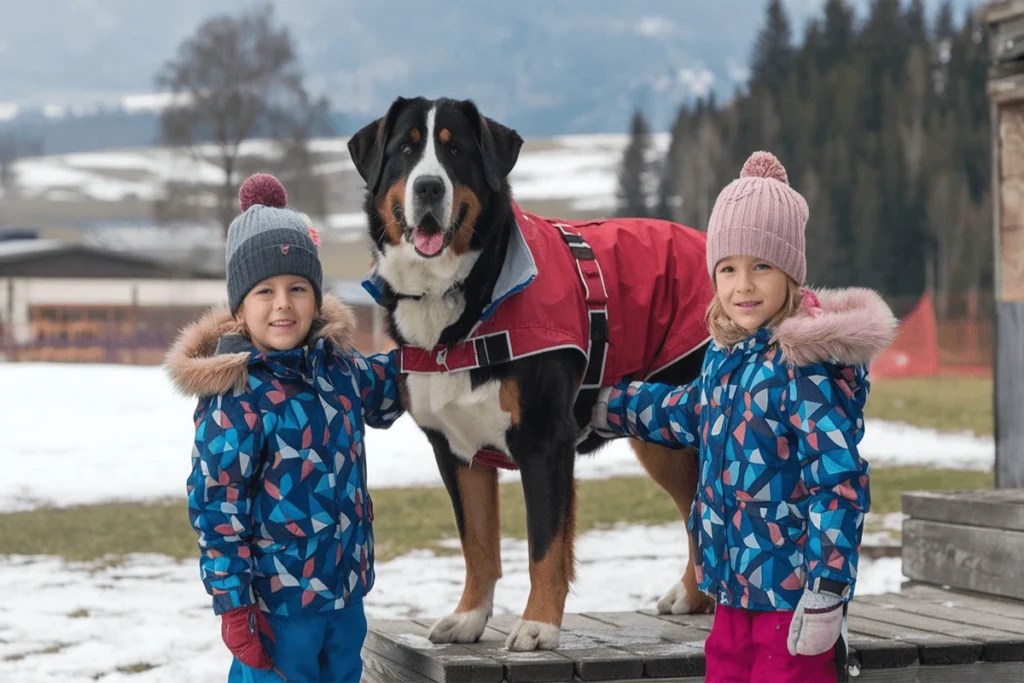
Swissies are also very intuitive. They can sense when a child needs comfort or when it’s time to join in the fun. Their protective instincts extend to children, often positioning themselves between kids and perceived dangers. Despite their size, they know how to be gentle and careful during play, which makes them a trusted friend to little ones.
Their ability to adapt to different family dynamics further enhances their appeal. Whether it’s a small family or a busy household, Swissies thrive on being part of the action. They are social, affectionate, and protective, making them an ideal choice for families with children who want a loving, dependable dog.
Caring for Your Greater Swiss Mountain Dog
Grooming Tips: Maintaining Their Tri-Colored Coat
The tri-colored coat of the Greater Swiss Mountain Dog is one of its most striking features. To keep it looking vibrant and healthy, regular grooming is essential. Their short, double coat consists of a dense undercoat and a smooth outer coat that naturally repels dirt and water. Brush your Swissy at least once or twice a week using a slicker brush or grooming mitt to remove loose hair and reduce shedding. During seasonal shedding periods, which occur twice a year, daily brushing may be necessary to manage the heavier shedding.
Baths should only be given as needed, usually every few months or when they get particularly dirty. Overbathing can strip their coat of natural oils, leading to dryness. Pay attention to areas like their chest and legs, where dirt and debris can accumulate. Additionally, regular nail trimming, ear cleaning, and teeth brushing are crucial for overall hygiene. Keeping up with these grooming habits will not only maintain their coat’s appearance but also ensure their comfort and health.
Exercise Requirements for an Active and Healthy Greater Swiss Mountain Dog
Greater Swiss Mountain Dogs are a working breed, so they have moderate to high exercise needs. They thrive on physical activities that challenge both their bodies and minds. A daily routine of at least 30 to 60 minutes of exercise is essential to keep them healthy and happy. Long walks, hikes, and play sessions in the backyard are great ways to meet their energy needs.
Swissies also enjoy activities that engage their natural instincts, such as pulling carts or participating in drafting competitions. These activities not only provide physical stimulation but also tap into their working heritage. Mental stimulation is equally important, so consider puzzle toys, obedience training, or agility courses to keep their minds sharp. While they enjoy being active, they are not overly hyper and can adapt to a more laid-back lifestyle as long as they receive consistent exercise. Failing to meet their activity needs can lead to boredom and unwanted behaviors, so regular physical and mental engagement is crucial.
Diet and Nutrition to Support Their Muscular Build and Overall Health
A balanced and nutrient-rich diet is vital for maintaining the muscular build and overall health of the Greater Swiss Mountain Dog. Due to their large size and active nature, they require high-quality dog food that provides adequate protein, healthy fats, and essential vitamins and minerals. Look for a formula specifically designed for large or giant breeds to support their growth and prevent joint issues.
Puppies, in particular, need food that supports controlled growth to avoid skeletal problems later in life. Feed them in measured portions to prevent overeating and reduce the risk of bloat, a common issue in large breeds. Adult Swissies typically require two meals a day, while puppies may need smaller, more frequent meals.
Include omega-3 fatty acids in their diet to promote a healthy coat and skin, as well as supplements like glucosamine and chondroitin to support joint health. You should always have clean water to drink, especially after you exercise. Avoid feeding them immediately before or after physical activity to minimize the risk of bloat. Consulting with your veterinarian can help you create a tailored diet plan that meets their specific needs and keeps them thriving.
Training and Socialization Tips for Swissy Dogs
Importance of Early Training and Socialization for Large Breeds
Early training and socialization are critical for the Greater Swiss Mountain Dog, especially given their large size and strength. A Swissy puppy that grows up without proper guidance can become challenging to manage as an adult. By starting early, you can shape their behavior and help them develop into well-mannered, confident, and balanced dogs.
Socialization should begin as soon as you bring your Swissy puppy home. Expose them to various environments, people, animals, and situations in a controlled and positive manner. For instance, take them on walks in busy parks, introduce them to friendly dogs, and expose them to common household noises like the vacuum cleaner. This helps prevent fear-based reactions and ensures they grow into adaptable adults.
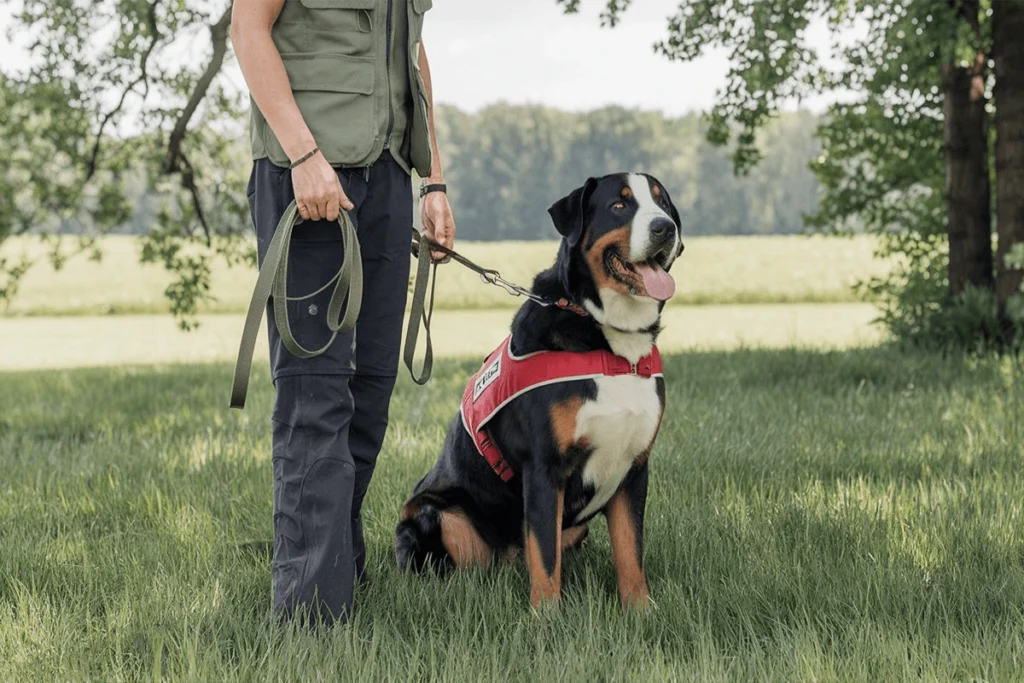
Early obedience training is equally important. Teaching basic commands like “sit,” “stay,” “come,” and “leave it” provides a foundation for further training and reinforces your role as the leader. Large breeds like Swissies are intelligent but can be stubborn at times, so consistent and positive training is essential.
Effective Training Techniques for Greater Swiss Mountain Dogs
The Greater Swiss Mountain Dog responds best to training methods that are positive, consistent, and reward-based. Harsh punishment or forceful methods can damage the bond between you and your dog and lead to fear or resistance. Instead, focus on encouraging desired behaviors through praise, treats, and play.
Start with short, engaging training sessions to hold their attention. Swissies are intelligent but can get bored with repetitive tasks, so keep lessons varied and fun. Use a firm but calm tone to convey commands, and always reward them for good behavior immediately to reinforce the connection.
Given their working heritage, Swissies thrive when they have a sense of purpose. Incorporate tasks that tap into their natural instincts, such as pulling a light cart, retrieving objects, or participating in structured obedience exercises. Training sessions should also emphasize self-control, as their size can make excitable behavior problematic. Teaching “wait” or “gentle” is especially important for this breed.
Activities and Best Practices to Keep Them Mentally and Physically Stimulated
Keeping the Greater Swiss Mountain Dog mentally and physically engaged is key to their happiness and well-being. As a working breed, they thrive when given tasks or challenges that allow them to use their strength and intelligence. Structured activities like cart pulling, herding, or even carrying a backpack during hikes are excellent options.
Daily walks and playtime are essential, but variety is equally important. Introduce puzzle toys or interactive feeders to stimulate their minds and prevent boredom. These activities not only keep them entertained but also discourage destructive behaviors that can arise from under-stimulation.
Training sessions can also double as mental stimulation. Practice obedience drills, teach them new tricks, or engage them in agility training. Social activities, such as playdates with other dogs or trips to dog-friendly parks, help them remain well-adjusted and confident in different environments.
Finally, ensure they have “downtime” with the family. Greater Swiss Mountain Dogs love being part of household routines, and their emotional well-being depends on feeling included. Combining physical exercise, mental stimulation, and family bonding creates a balanced lifestyle that keeps your Swissy happy and well-behaved.
Why the Greater Swiss Mountain Dog Is Perfect for Active Families
Best Activities for Greater Swiss Mountain Dog (Hiking, Drafting, Herding)
The Greater Swiss Mountain Dog, a natural working breed, thrives in activities that engage both their strength and intelligence. Given their history as draft and herding dogs in the Swiss Alps, they excel in tasks that allow them to use their natural abilities and instincts.
- Hiking: Swissies love exploring the outdoors and are excellent companions for hiking adventures. Their sturdy build and endurance make them capable of tackling long trails and uneven terrain. Equipping them with a dog backpack to carry lightweight items gives them a sense of purpose while exercising. Always ensure they stay hydrated and avoid overexertion in hot weather.
- Drafting: Drafting, or cart-pulling, is one of the Swissy’s favorite activities. Historically, they were used to transport goods, and this instinct remains strong today. Training your dog for carting or participating in drafting competitions can be a fun and rewarding experience for both you and your Swissy. Start with light loads and gradually increase the weight as they become more confident and skilled.
- Herding: Herding comes naturally to Swissies, as they were historically used to guide cattle. Engaging them in herding trials or providing them with opportunities to herd (even if it’s just chasing a ball or guiding toys) satisfies their instinctual drive. This activity also helps build focus, discipline, and teamwork between you and your dog.
Other fun activities for Swissies include agility courses, obedience trials, and even swimming, which many enjoy. These activities not only keep them physically fit but also strengthen the bond between you and your dog.
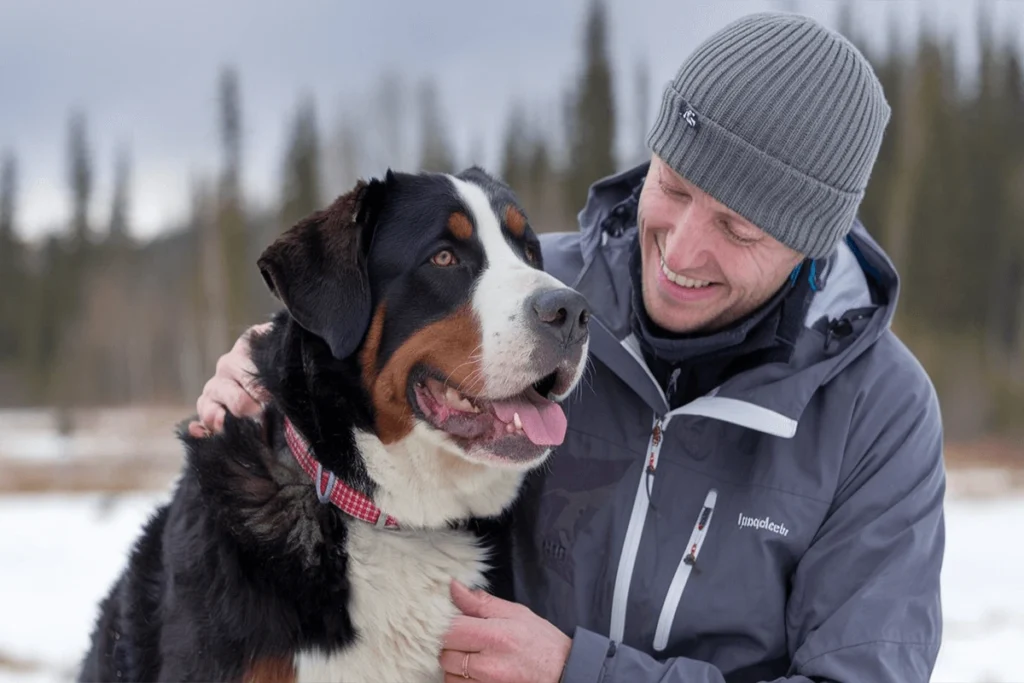
How Greater Swiss Mountain Dog Thrives in an Active Household
The Greater Swiss Mountain Dog is happiest in an active household where they are included in family activities. These dogs are social and thrive when they have a role to play within the family dynamic. They are not couch potatoes—they need daily physical and mental stimulation to stay healthy and content.
An active household provides them with opportunities to engage in long walks, backyard play sessions, and family outings. Swissies enjoy being part of family routines, whether it’s accompanying you on errands, playing with kids, or simply being present during social gatherings. Their love for human interaction makes them unsuitable for homes where they would be left alone for extended periods.
Swissies also thrive on consistency and structure. An active household that integrates regular walks, playtime, and training sessions into their routine ensures that their energy is channeled constructively. Families that enjoy outdoor adventures, such as hiking or camping, will find the Swissy to be an enthusiastic and dependable companion. A happy Swissy is one that feels included and has plenty of opportunities to stay active.
Common Health Issues and How to Keep Them Healthy and Happy
As a large breed, the Greater Swiss Mountain Dog is prone to certain health issues that owners should be aware of to ensure their dog’s well-being. Some of the most common concerns include:
- Hip and Elbow Dysplasia: These joint conditions are common in large breeds and can lead to pain or mobility issues. To minimize the risk, ensure your Swissy maintains a healthy weight and avoid excessive exercise during puppyhood when their bones are still developing. Regular vet check-ups and joint supplements like glucosamine can also help.
- Bloat (Gastric Dilatation-Volvulus): Bloat is a life-threatening condition that affects deep-chested breeds like the Swissy. To reduce the risk, feed your dog smaller, more frequent meals and avoid exercise immediately before or after eating. Always monitor them for signs of distress, such as restlessness, drooling, or a swollen abdomen.
- Osteochondrosis Dissecans (OCD): This orthopedic condition can occur in fast-growing puppies. Providing a balanced diet that supports slow, steady growth and avoiding excessive physical strain during development can help prevent OCD.
- Eye Issues: Swissies may develop conditions like cataracts or distichiasis (extra eyelashes). Regular eye checks can help detect and address problems early.
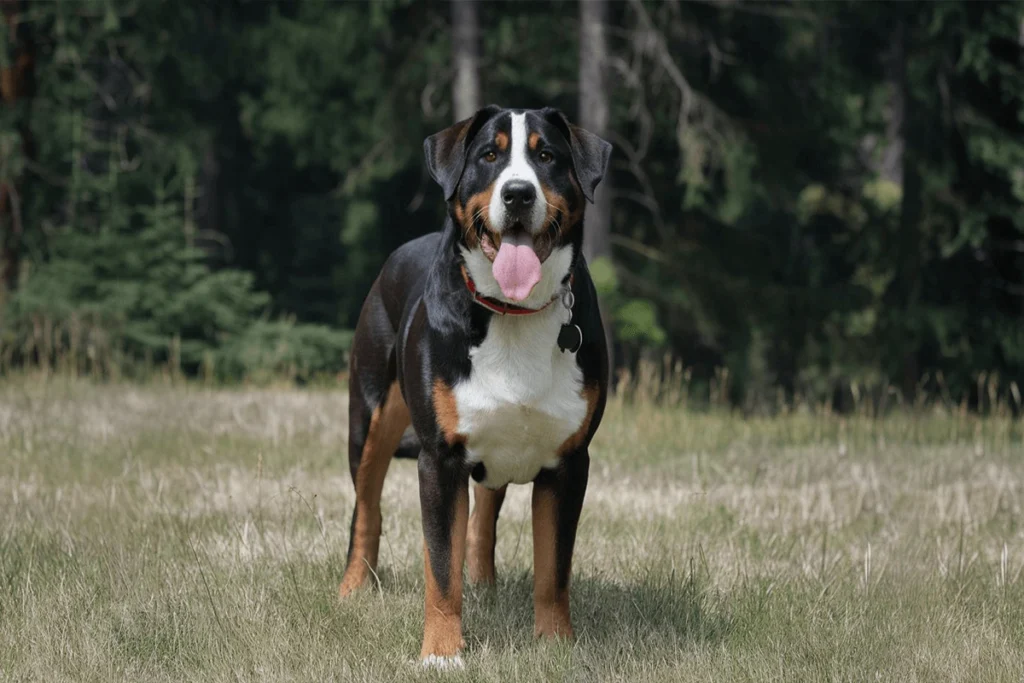
To keep your Swissy healthy and happy, focus on a balanced lifestyle. Provide high-quality dog food tailored to large breeds, maintain an active routine that includes both physical and mental stimulation, and prioritize preventive care with regular veterinary visits. Combine these efforts with lots of love and attention, and you’ll have a healthy, thriving Swissy who enjoys life to the fullest.
Conclusion
The Greater Swiss Mountain Dog captivates hearts with its rich history, striking appearance, and charming personality. Originating from the Swiss Alps, these majestic dogs are known for their loyalty, intelligence, and gentle disposition. Their tri-colored coat and muscular build give them a commanding yet friendly presence, making them hard to resist.
Their natural inclination to bond with families makes them an ideal companion, especially for those who lead active lifestyles. They thrive in environments where they can participate in outdoor activities like hiking, drafting, and herding. The Swissy’s ability to adapt and integrate seamlessly into family life highlights their versatility and enduring appeal.
To ensure a happy and healthy Swissy, it’s essential to meet their grooming needs, provide a nutritious diet, and engage them in regular exercise. Early training and socialization play crucial roles in shaping their behavior and maintaining their well-being. With the right care and attention, the Greater Swiss Mountain Dog not only becomes a loyal protector but also a cherished member of the family.
In the end, it’s their loving nature, unwavering loyalty, and zest for life that truly win hearts everywhere. Whether exploring the great outdoors or enjoying quiet moments at home, the Swissy continues to leave an indelible mark on everyone they meet. Their affectionate and dependable character cements their place as one of the most beloved breeds, perfect for families who value companionship and adventure.
Lean How To Train your Greater Swiss Mountain Dog Puppy Professionally Here.
Find The Top Key Differences Between Greater Swiss Mountain Dog vs Bernese Here.
You Can Learn More about the Giant Dogs Breeds From Here
Discover His Other Giant Brother “Bernese Mountain Dog“
Find The Best Stuff For your Pet on PetMD Official
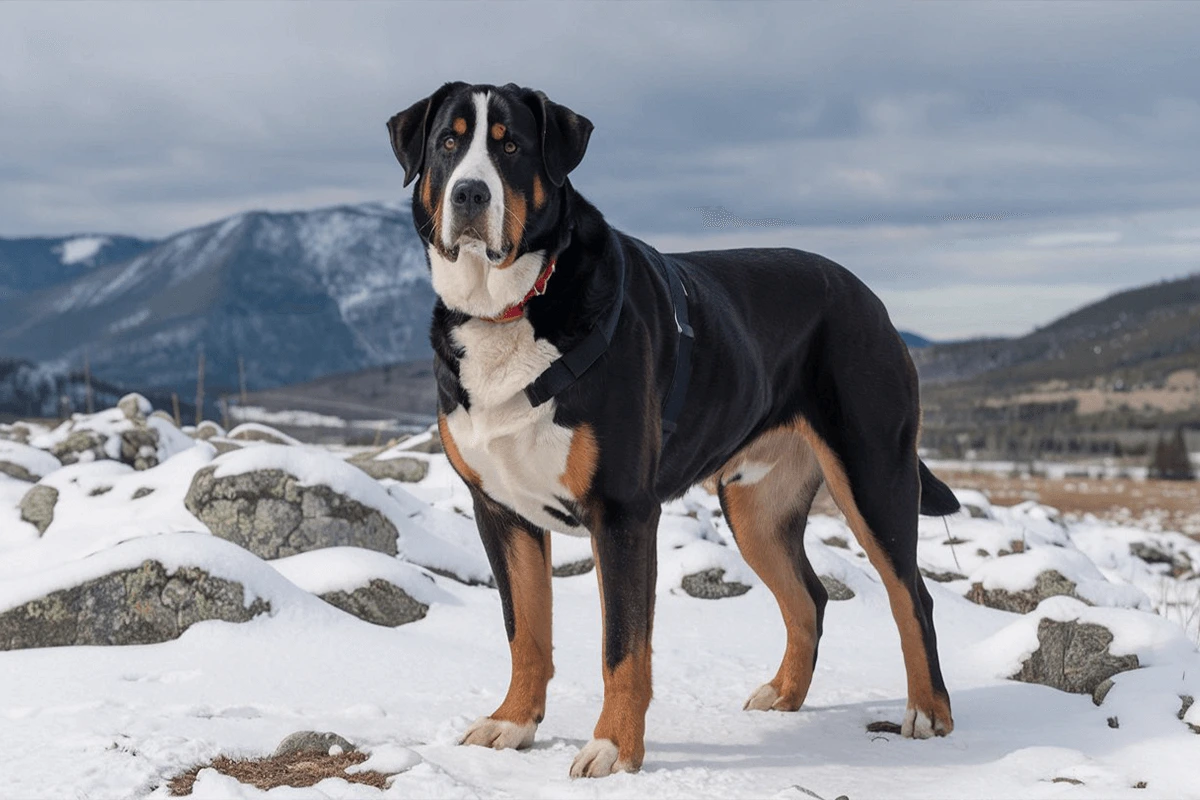
3 thoughts on “How the Greater Swiss Mountain Dog Wins Hearts Everywhere”
Comments are closed.